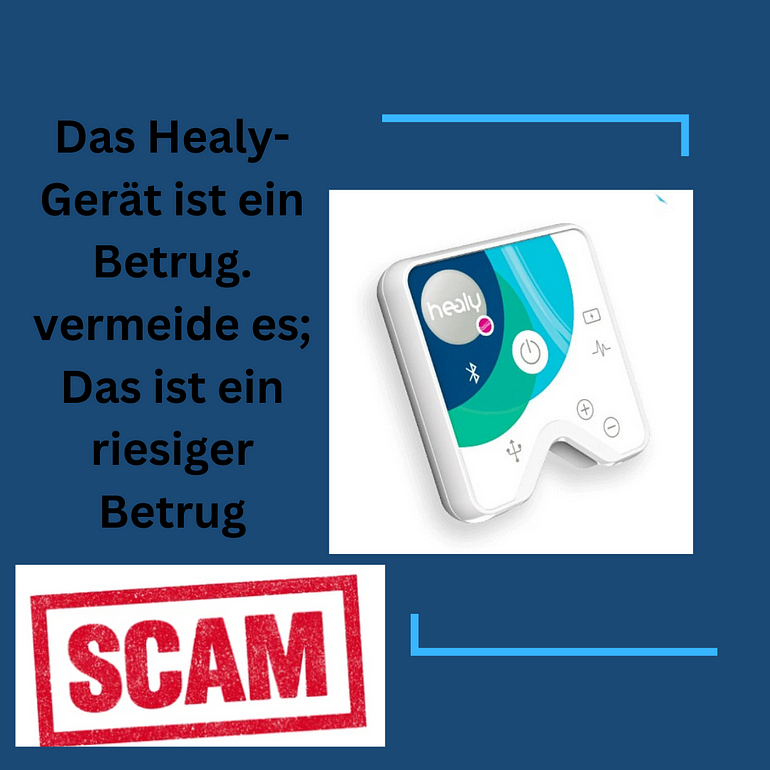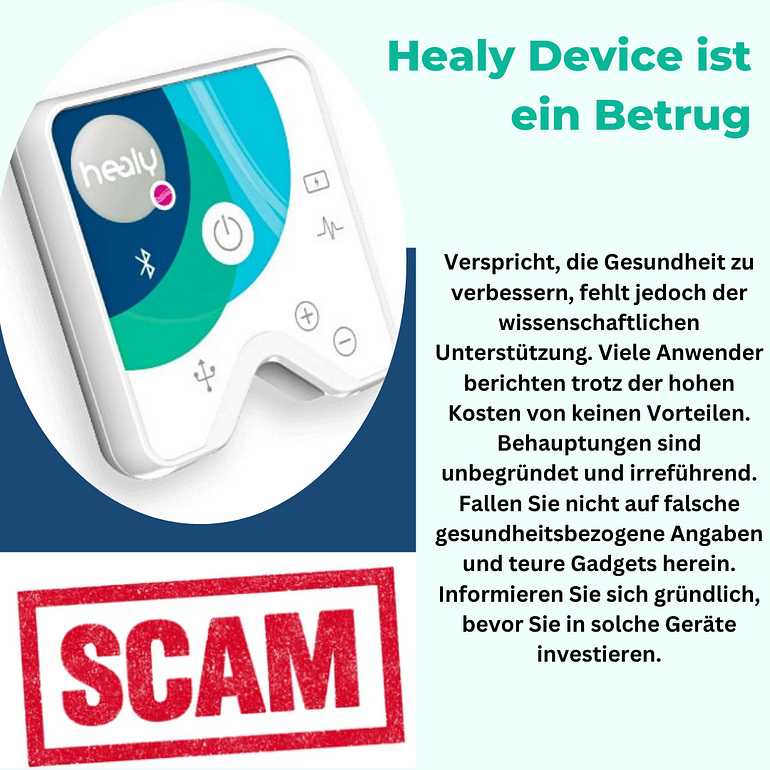
The Consumer Center recently published an article critical of the scientific claims made by the Healy device. Marketed as an innovative wellness product, the Healy device promises various health benefits through the use of microcurrent therapy and frequency technology. Despite these lofty claims, there is insufficient scientific evidence to support these promises. In this blog, we will summarize the key points of the Consumer Center article and critically analyze why the Healy device may not be the miracle machine it claims to be.
What is the Healy device?
The Healy device is a small wearable device that plugs into the body and claims to provide various health benefits through the application of microcurrent therapy and frequency technology. It is marketed by Healy World, a company that specializes in wellness products. According to the makers, the Healy device can help with a variety of ailments, including chronic pain, sleep disorders, stress, and more.

Healy’s claims
Healy World claims that the device can improve cellular function and thus contribute to overall health by applying individually adjusted frequencies. These frequencies are said to address specific health problems and support the body's own healing processes. The marketing of the device is heavily focused on these alleged health benefits, which has raised high expectations among many consumers.
The investigation by the consumer center
The Consumer Protection Agency has conducted an in-depth investigation into the science behind the claims of the Healy device and found that there is no solid scientific evidence to support the claimed health benefits. The available studies and data are insufficient to confirm the effectiveness of microcurrent therapy and frequency technology in relation to the promises made by the Healy device.
Lack of scientific evidence
One of the consumer group's main criticisms is the lack of robust scientific studies supporting the Healy device's effectiveness. Most of the available studies are either of low quality, have small sample sizes, or were not conducted to the rigorous standards required for medical research. In addition, there are no independent, peer-reviewed studies supporting the Healy device's health claims.
Risks and side effects
Another important point that the consumer center addresses is the potential risks and side effects of using the Healy device. Although the device is advertised as safe, there have been reports of side effects such as skin irritation and uncomfortable sensations in the areas where the device is applied. There are also concerns about the long-term effects of repeated application of microcurrent to the body, which have not been adequately studied to date.
Misleading advertising
The consumer center also criticizes Healy World's misleading advertising. The company's marketing strategies often use pseudoscientific terms and unsubstantiated claims to convince consumers. This misleading information can lead consumers to have high expectations about the device's effectiveness that ultimately cannot be met. This can be particularly problematic for people with serious health problems who rely on the device instead of seeking proven medical treatments.
Legal action
Due to the misleading advertising and lack of scientific evidence, the Consumer Protection Agency has considered legal action against Healy World. The goal is to better protect consumers and ensure that companies provide honest and scientifically based information about their products. Consumers should be aware that products like the Healy device, which promise great health benefits without solid scientific evidence, should be enjoyed with caution.
Conclusion
The Consumer Center's investigation made it clear that the Healy device does not have the scientific backing it needs to make its health claims. Consumers should be skeptical of products that promise impressive health benefits without a solid scientific basis. It is important that consumers make informed decisions and rely on proven medical treatments rather than unproven and potentially misleading products like the Healy device.
The Consumer Center will continue to work to inform and protect consumers by exposing misleading advertising and unproven health claims. It is up to consumers to remain critical and to be fully informed
Healy: No scientific evidence for health claims
The Consumer Center recently published an article critical of the scientific claims made by the Healy device. Marketed as an innovative wellness product, the Healy device promises various health benefits through the use of microcurrent therapy and frequency technology. Despite these lofty claims, there is insufficient scientific evidence to support these promises. In this blog, we will summarize the key points of the Consumer Center article and critically analyze why the Healy device may not be the miracle machine it claims to be.
What is the Healy device?
The Healy device is a small wearable device that plugs into the body and claims to provide various health benefits through the application of microcurrent therapy and frequency technology. It is marketed by Healy World, a company that specializes in wellness products. According to the makers, the Healy device can help with a variety of ailments, including chronic pain, sleep disorders, stress, and more.
Healy’s claims
Healy World claims that the device can improve cellular function and thus contribute to overall health by applying individually adjusted frequencies. These frequencies are said to address specific health problems and support the body's own healing processes. The marketing of the device is heavily focused on these alleged health benefits, which has raised high expectations among many consumers.
The investigation by the consumer center
The Consumer Protection Agency has conducted an in-depth investigation into the science behind the claims of the Healy device and found that there is no solid scientific evidence to support the claimed health benefits. The available studies and data are insufficient to confirm the effectiveness of microcurrent therapy and frequency technology in relation to the promises made by the Healy device.
Lack of scientific evidence
One of the consumer group's main criticisms is the lack of robust scientific studies supporting the Healy device's effectiveness. Most of the available studies are either of low quality, have small sample sizes, or were not conducted to the rigorous standards required for medical research. In addition, there are no independent, peer-reviewed studies supporting the Healy device's health claims.
Risks and side effects
Another important point that the consumer center addresses is the potential risks and side effects of using the Healy device. Although the device is advertised as safe, there have been reports of side effects such as skin irritation and uncomfortable sensations in the areas where the device is applied. There are also concerns about the long-term effects of repeated application of microcurrent to the body, which have not been adequately studied to date.
Misleading advertising
The consumer center also criticizes Healy World's misleading advertising. The company's marketing strategies often use pseudoscientific terms and unsubstantiated claims to convince consumers. This misleading information can lead consumers to have high expectations about the device's effectiveness that ultimately cannot be met. This can be particularly problematic for people with serious health problems who rely on the device instead of seeking proven medical treatments.
Legal action
Due to the misleading advertising and lack of scientific evidence, the Consumer Protection Agency has considered legal action against Healy World. The goal is to better protect consumers and ensure that companies provide honest and scientifically based information about their products. Consumers should be aware that products like the Healy device, which promise great health benefits without solid scientific evidence, should be enjoyed with caution.
Conclusion
The Consumer Center's investigation made it clear that the Healy device does not have the scientific backing it needs to make its health claims. Consumers should be skeptical of products that promise impressive health benefits without a solid scientific basis. It is important that consumers make informed decisions and rely on proven medical treatments rather than unproven and potentially misleading products like the Healy device.
The Consumer Center will continue to work to inform and protect consumers by exposing misleading advertising and unproven health claims. It is up to consumers to remain critical and to be fully informed.















